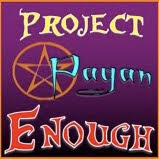Yesterday was the Summer Solstice in the northern hemisphere: the day with the most hours of light and the fewest hours of darkness in Earth's 24-hour cycle.
Summer Solstice, or Litha, is one of the eight solar holidays often observed by Pagans of different traditions. Summer Solstice itself is an occurrence, something that happens in nature. In many traditions, what makes something a holiday is two things: its occurrence in nature, and what that means to us.
Here's some neat info about the science involved, about the actual occurrence of the Summer Solstice. A Google search for Summer Solstice or Litha can tell you a fair amount about what different traditions have published on the internet about what it means to them.
As someone striving to live her life more in harmony with nature, as someone to whom nature itself is sacred, developing the habit of being more, and more deliberately, aware of what's happening in the natural world around me has been both neat and helpful. Knowing when the Solstices, Equinoxes, and cross-quarter days are helps to orient me to the year, the seasons, and the dark and light; it's kind of like a seasonal compass I always have with me. When it feels like winter's never going to end, or like it's going to be hot much longer than I can tolerate, or I'm wondering why the flowers aren't here yet or the leaves haven't turned yet, knowing where I am in the Wheel of the Year helps me keep perspective.
Some of the places on the Wheel of the Year are pretty intuitive to me -- especially Beltane, Samhain, and Yule. Those are ones where what's happening in the world around me and in my spiritual life are easily and obviously in tune. Litha has always been less intuitive for me. In some ways, that's good: I don't have an investment in doing certain kinds of spiritual work at Midsummer; I can take, perhaps, a more frank look at what's happening in nature and how that is or isn't echoed in my own spiritual life. In some ways, it's harder, because I don't have an established pattern that usually meets my needs.
So, what is happening in nature around me right now?
This is a confused summer here in southeastern Michigan. Our spring and summer have been slow, and cold, for the most part. And rainy: the mold count is high, and I'm having the unusual occurrence of spring allergies and a spring asthma flare-up. After a colder than usual season, we had unexpected heat -- temps in the 90s F -- and when that passed, drops down to the 40s and 50s at night, and 60s and 70s during the day.
I'm used to Lithas that are hot and sticky, and occasionally merely warm. So in a lot of ways, it doesn't quite feel like Solstice yet to me.
But things are blooming, and early veggies are appearing at the Farmers' Market. This is probably the last week for asparagus. There's still rhubarb. Looking out into our yard, what I see in bloom are the star gazer lilies, the astilbe, and the catalpa tree.
I'm reminded a lot of last year's Solstice. I spent it, of all odd things, doing peace work on a military base several hours north of here. It was chilly -- I was in fleece and long pants the whole four days I was there -- but the days were long. I remember walking between buildings at 10:30 at night, and being amazed at the shade of indigo that was the sky.
Right now, in Ann Arbor, the sun rises at 5:58 am, and sets at 9:15 pm. (It really is different "back home": in Philadelphia, the sun rises at 5:32 am, and the sun sets at 8:33 pm.) (Hmmm. In Seattle, where we're moving in August, it's 5:11 am and 9:11 pm. Wow!)
I am getting ready for FGC Summer Gathering, which I'm looking forward to with joy and with some stress. I'm having an allergy and asthma flare-up, which is making it hard for me to feel at peace with my body and with the weather. (If it weren't so rainy, it wouldn't be so moldy, and my lungs would be working better!) I am wishing for more of what I think of as Summer Solstice weather for this area: sunny and warm, not too hot, with occasional Midwestern-typical thunderstorms in the afternoons.
What's happening in the natural world around you just now?
What's happening in your spiritual life?
What does Summer Solstice mean to you?







